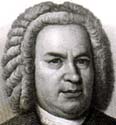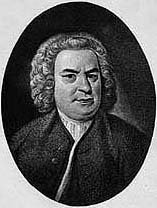The Present Day Misconceptions About Bach Performance Practice in the 19th Century - The Evidence of the Recordings Pages at the Teri Noel
Towe Home Pages - Page 3 - Joseph Joachim
Johann Sebastian Bach
Present Day Misconceptions
About Bach Performance Practice in the Nineteenth Century
The Evidence of the Recordings
This remarkable photograph is not a computer generated composite; the original of the Weydenhammer Portrait Fragment, all that
remains of the portrait of Johann Sebastian Bach that belonged to his pupil Johann Christian Kittel, is resting gently on the surface
of the original of the 1748 Elias Gottlob Haussmann Portrait of Johann Sebastian Bach.

1748 Elias Gottlob Haussmann Portrait, Courtesy of William H. Scheide, Princeton, New Jersey
Weydenhammer Portrait Fragment, ca. 1733, Artist Unknown, Courtesy of the Weydenhammer Descendants
Photograph by Teri Noel Towe
©Teri Noel Towe, 2001, All Rights Reserved
PRESENT DAY MISCONCEPTIONS
ABOUT BACH PERFORMANCE PRACTICE IN THE NINETEENTH CENTURY
THE EVIDENCE OF THE RECORDINGS
Page 3
Joseph Joachim
At the time that Siegfried Ochs and Hans Weisbach were students at the Hochschule für Musik in Berlin, the head of the institution
was Joseph Joachim. When Ochs, who himself would take charge of the oratorio department many years later, was a pupil there,
Joachim was in his mid-forties and at the zenith of his career. Weisbach matriculated at the school during the last decade of
Joachim's life, but the by then old man remained a powerful force in musical life in Europe in general and at the Hochschule in
particular.
Born in 1831, Joachim had been a child prodigy, and, at the age of 13, he came to Leipzig, where he became a protegé of Felix
Mendelssohn-Bartholdy, with whom he frequently played duos and who arranged for him to study with Ferdinand David and
Moritz Hauptmann. The dedicatee of the Mendelssohn-Bartholdy Violin Concerto in E Minor, Op. 64, David was very much
interested in old music in general, as his famous Die hohe Schule des Violinspiels indicates, and in Bach in particular. Hauptmann
had just recently begun what was to be a 22-year tenure as Cantor of the Thomasschule and was to be one of the founders and
principal editors of the Bach-Gesellschaft edition. Like Mendelssohn-Bartholdy, both David and Hauptmann were creators of the
"classic" Leipzig style of Bach performance that was firmly rooted in the late 18th- and early 19th-century performance tradition in
which all three had been trained and that conformed naturally to the equally "classical," conservative performance style that they
adopted for their own compositions. This style of Bach performance quickly became the standard in Berlin and Leipzig, throughout
Germany, and, by extension, in England, to which Mendelssohn-Bartholdy, and later Joachim, both had strong ties. Its influence
proved strong throughout much of the rest of Europe as well.
Joachim was conservative by inclination as well as by training. His predilection was well known to the public by 1868, when he
moved to Berlin and assumed the directorship of the Hochschule fur Musik (at that time called the Hochschule fur Ausübende
Tonkunst). His conservatism, coupled with his forceful personality and his practice of teaching by example, assured that his
reverence for the old ways of doing things would be impressed upon his students and passed on to those of a similar
predisposition.
In 1903, four years before his death, Joachim made a handful of records for the Gramophone & Typewriter Company. It is
significant that two of those five sides are recordings of unaccompanied violin works by Bach, particularly when one recalls not
only that Joachim was one of the founders of the Neue Bach-Gesellschaft but also that he studied the Bach Unaccompanied
Sonatas and Partitas with David. One of the sides contains the Adagio from the Sonata No. 1 in G Minor, BWV 1001 (duration:
3 minutes, 31 seconds) [13]; the other is the Tempo di Borea from the Partita No. 1 in B Minor, BWV 1002 (duration: 1 minute, 52
seconds). [14] The two performances accurately reflect Hanslick's description of Joachim's playing as not only "great, noble, and
free" but also "of unbending seriousness." [15] It is difficult to determine an overall tempo for the Adagio because Joachim's
reading is rhapsodic - but never undisciplined. The fundamental tactus ranges from quarter note = mid 40s to quarter note = mid
50s, with occasional accelerations and ritards that go beyond that overall range, from a low of quarter note = 36 to a high of quarter
note = 64. The Tempo di Borea is much more straightforward. The basic tempo is half note = 95 to 100, with a quickening to half
note = 100 to 104, beginning at the 25th bar after the repeat sign, continuing through the passages of rapid figuration but ultimately
returning to the original tempo.
Despite his splendid sense of the rhapsodic, so much in evidence in the Adagio, Joachim's interpretations are remarkably "straight,"
especially when compared to the Bach recordings of Fritz Kreisler, who is the "old time" fiddler that most immediately think of
when the great violinists of the early part of this century are under discussion. Joachim's tempos are brisker that one would expect,
and there is also less portamento than one would have anticipated; in fact, there are many fewer slides than appear to have been the
norm at the time. In spirit and in style, these performances clearly have much in common with Ochs and Weisbach ones. Perhaps
most importantly, these two discs, the first recordings of unaccompanied Bach, made by one of the oldest and most conservative
violinists to record during the infancy of the commercial gramophone, are a precious link to the Bach playing of David,
Mendelssohn-Bartholdy, and the other founders of the Leipzig school of Bach performance.
Please click on  to advance to Page 4 - Sir Adrian Boult and Sir Eugene Goossens.
to advance to Page 4 - Sir Adrian Boult and Sir Eugene Goossens.
Click on  to return to the Johann Sebastian Bach Index Page.
to return to the Johann Sebastian Bach Index Page.
Click on the  to return to the Teri Noel Towe Welcome Page.
to return to the Teri Noel Towe Welcome Page.
teritowe@alumni.Princeton.EDU
Copyright, Teri Noel Towe, 1985, 1986, 1988, 1989, 2001
All Rights Reserved
The Present Day Misconceptions About Bach Performance Practice in the Nineteenth Century - The Evidence of the Recordings
Pages at the Teri Noel Towe Home Pages
are PPP Free web pages.

The Present Day Misconceptions About Bach Performance Practice in the Nineteenth Century - The Evidence of the Recordings
Pages at the Teri Noel Towe Home Pages have received
the HIP Woolly Mammoth Stamp of Approval from The HIP-ocrisy Home Page.